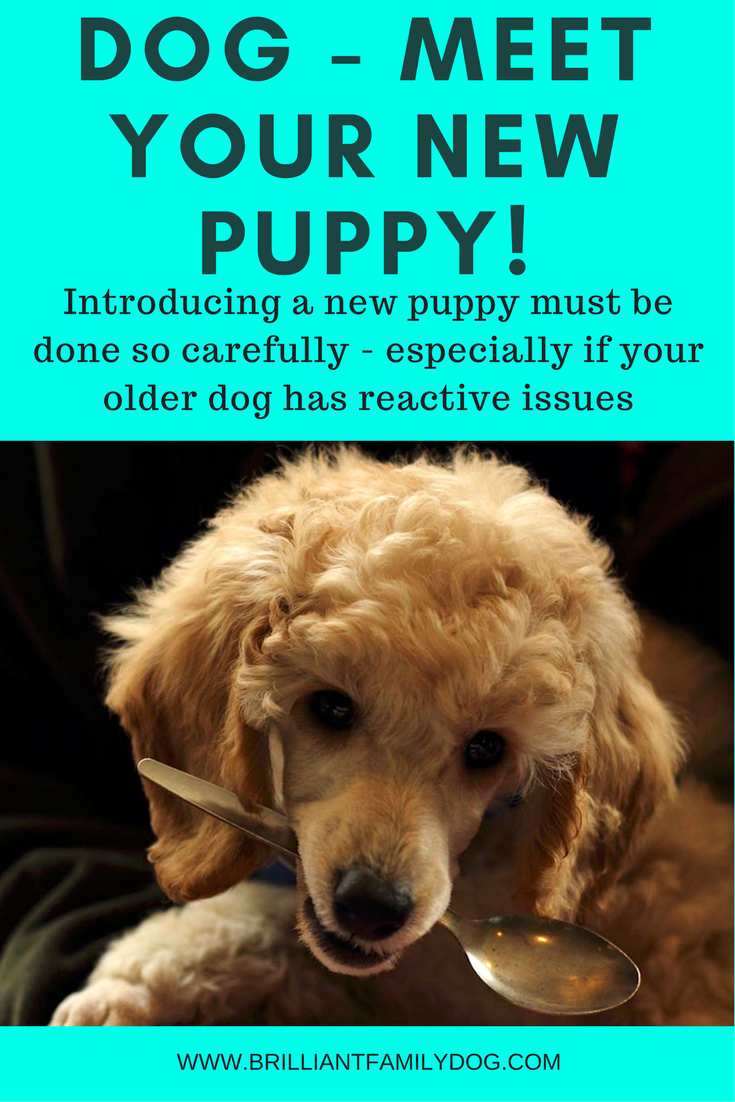Rollo the Border Collie initiates play with Coco Poodle at 15 weeks - 7 weeks after he arrived!
Many people who have a reactive dog - one who looks ferocious to strange dogs - wonder if they can ever have a puppy again. And they wonder if their reactive dog would accept the puppy or whether it would all end in tears.
They may long to give their anxious dog a playmate. This is a nice reason - but quite a lot of dogs are not very interested in playing with other dogs. Even in my busy household, play between any or all of the dogs only happens occasionally - and fairly briefly - and when they’re already excited about something. There are lots of smaller interactions going on, of course, but not necessarily play.
Whether this is the right step for you is something you have to assess with your individual dog. Most adult dogs will - eventually - accept a puppy into the home. Some take a long time, while others are delighted and bond immediately with the newcomer, their behaviour perfectly appropriate and gentle. You can get an idea from your dog’s reaction to a very young puppy by allowing him to see one - but your first consideration here would be the safety and wellbeing of the puppy. Early bad experiences can be hard to erase. So possibly a puppy held in someone’s arms, behind a fence, while your dog observes from whatever is a safe and appropriate distance where he won't bark and frighten the pup.
So assuming that passed off peaceably enough, actually introducing a young puppy into the home will present its own challenges!
If your reactive dog is one of those who is not keen on puppies in his face - like my Border Collie Rollo - you’ll need to keep them largely apart for a long while. But it can all come good in the end, and Rollo is now totally accepting of the three younger dogs in the household, and often initiates play with them. When he’s had enough, the game ends.
Start the change with your reactive, anxious, aggressive - Growly - dog with our free Masterclass packed with ideas and strategies, all force-free
“Puppy, meet Dog”
So you may be surprised - and delighted - at the success of the initial introductions. But this is only the beginning! I just want to give you a little guidance going forward.
You need to focus largely on your new puppy for the next 9 months or so. He’s only going to learn if you put in the flying hours!
New pups should be kept separate from older dogs most of the time. Yes - most of the time. You can’t just chuck ‘em in together and hope that it will all go swimmingly. It’s easy to keep them separate because your new puppy needs to sleep around 17+ hours a day, so all that sleeping time should be spent in his crate, in a playpen, or in a separate room. A playpen that opens out as a zigzag that will divide a whole room is really helpful for when the puppy is awake. Last time I had a puppy in the house, the playpen formed a long barrier across the kitchen. The older dogs could go in and out of the garden, upstairs, wherever they wanted, but I didn’t have to worry about the pup’s safety if he annoyed them. So the dogs were not excluded, and could study the new creature in the secure knowledge that they couldn’t be molested by the tiny fluffball!
And here's a great post about how to use a playpen for best results
Remember that your older dog didn’t choose to get a puppy - you did!
The general rule of thumb is that your new puppy can play with your older dog for one third of the time he plays with you. So if you interact/train/play with your puppy for one hour a day, that means he gets twenty minutes playing with the older dog - preferably in 3-5 minute chunks through the day. People gasp when I tell them this, as I can see in their eyes that they’re reflecting on the fact that at the moment their dogs have 24/7 access and are forever playing roly-poly games on the carpet. But it’s something you have to do. These early weeks and months are such a valuable time for bonding with your new charge - don’t waste them!
If you leave the two dogs together all the time during this vital developmental stage, you’ll end up with a young dog who only listens to the other dog, and never listens to you. (Don’t be like the owner who said to me, “I wish I’d listened to you 6 months ago. Now we’ve just got two hooligans.”)
Take time developing play with your puppy. Our play is not as natural as dog-dog play, so you have to work at it. Tug is a great game that harnesses the puppy’s instinctive drive - which all types and breeds of dog have - to locate prey, stalk it, chase it, catch it, and kill it. Taught properly this game builds huge impulse control in your dog. (And uses up loads of energy - yay!)
Respect your older dog and make sure he always has space and is never pestered - especially if he’s not so agile any more. Imagine visiting a friend’s house and her children treat you as a climbing frame, poking fingers into your mouth and ears - no, you wouldn’t like it! Sooner or later your puppy will lose his puppy licence and your older dog will say, “That’s it! I’ve had enough!” and snap (or worse) at him. Ensure this can never happen.
Make sure to have lots of private time with your faithful older dog, alone. As he is reactive and has his own issues and worries, you’ll need to continue your program to make life easier for him when out. While your training focus should be firmly on your puppy, whose developmental stages will fly by if you’re not paying attention, you’ll find that two dogs does not equal half the work (as you may have thought) but at least twice the work!
Never leave the two alone together. Just never. Not just for their safety, but also because what may seem a bad idea to a lone dog (like shredding the cushions) may take on a different hue when a young ragamuffin says “Let’s! I dare you!” When you’re not with them, they should both be asleep.
Remember that your prime task right now is introducing your puppy to our world and everything in it, before he reaches the age of 14-15 weeks. The socialisation window gradually closes between 12 and 16 weeks and new things met after that can result in distrust or fear. Follow closely a good guide on Puppy Socialisation, Habituation, and Familiarisation, and ensure all novelty is experienced with a calm, happy puppy. You know a lot about dog body language by now from your reactive dog: watch your puppy like a hawk to learn his signals.
Don’t make the common and disastrous mistake of thinking that playing with your older dog at home is a substitute for thorough and careful socialisation! Your brand new puppy doesn’t have to meet dogs yet, but definitely has to see loads of them. All different activity types, colours, coats, ears - they’re all different and new pup needs to experience all of them. Carry him if he hasn’t had his jabs yet.
And NO group walks for now. Reactivity is highly catching, so you want to introduce your puppy to the outside world with no fears and poor examples to copy. I wouldn’t walk my new puppy with my reactive dog till pup is at least 6 months (depending on breed - larger dogs 9-12 months minimum).
You have the rest of your lives together to enjoy a great relationship - between you and your older dog, between you and your new dog, and between the two dogs themselves. Don’t hurry and skip any of these vital steps. The time will fly by much faster than you anticipate.
Anything you may regard as restrictive at first sight will be seen to be just plain ole commonsense - and will become an automatic part of your management plan for your household.
Want a step-by-step guide to everything you need to know about your new puppy? Get New Puppy! here, and start on the right paw!
Once your puppy is about 9 weeks old and has settled in with you, you can start working through the Brilliant Family Dog series of how-to e-books. Everything is broken down for you into little steps - and what’s more, check the calm down book! Go get it now.
And hunt around the Blog to find help with Housetraining, Sleeping through the Night, and so on.




